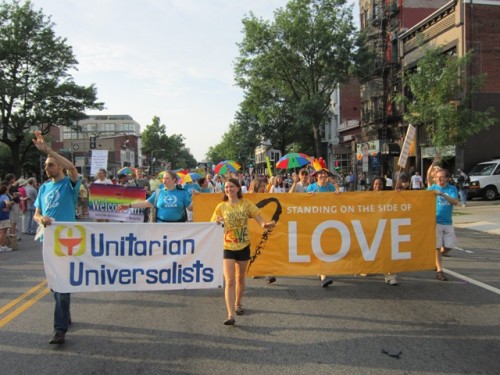[Brendan Myers, Ph.D., is the author of numerous books on mythology, philosophy, ethics, and culture. As far as he’s aware, he is the only openly-pagan philosophy professor in the entire world. Originally from a small town in Ontario, Canada, he now lives in Quebec, where the beer is much better. The following is an excerpt from his forthcoming book, “Circles of Meaning, Labyrinths of Fear”.]
Our world is utterly saturated with fear. We fear being attacked by religious extremists, both foreign and domestic. We fear the loss of political rights, a loss of privacy, or a loss of freedom. We fear being injured, robbed or attacked, being judged by others, or neglected, or left unloved. We fear succumbing to an exotic pandemic disease, or losing our homes to catastrophic storms induced by climate change and global warming. We fear the social breakdown that abortion, divorce, and same-sex marriage will supposedly cause. We fear foreign immigrants with their strange customs, coming to our neighborhoods to take our jobs, drain our welfare state, or commit crimes. We have existential fears such as the fear of death, fear of freedom itself, fear of the afterlife, fear of being ‘unreal’ (a surprisingly common one, although difficult to describe), and fear of loneliness and isolation. You might boast of having none of these fears. Yet there is a part of your mind which knows that certain boundaries must not be crossed. We see certain consequences befalling the unprepared, the disbeliever, the nonconformist, the Socratic gadfly. And so we supervise ourselves. We subscribe to moral and political values that separate us from each other, instead of unite us, such as competition, and individualism. We immerse ourselves in escapist mass entertainment, such as ‘reality TV’ programs. We support fanatical politicians and preachers. Our politicians, in turn, support dictators and tyrants in other countries, all in the name of ‘security’ and ‘stability’. And we arm ourselves to the teeth, and pray to God to be saved. Thus even when we say we have no fear of these things, fear still governs our minds.
But life does not have to be that way. There is nothing natural, inevitable, or necessary about the labyrinth of fear. We can liberate ourselves. There are better ways to live. Someone has to take the initiative to love and trust her fellow living creature, and set us all free.
Yet this book is not just about social and moral problems. It is about people and relationships. It is about what our lives might look like if we were not so profoundly governed by fear. As we have seen, fear tends to emerge from disordered and dysfunctional relationships. For one of the deepest and most debilitating fears we endure is the fear of other people. We fear what they might do or say, how they may act, whether they will judge you, harm you, steal from you, interfere with your life, perhaps kill you, or simply ignore you. The liberation from fear requires a better understanding of our relationships, and a rectifying and a healing of our relationships. In that sense, this book offers not one way, but twenty-two ways, to escape the labyrinth.
I also think that liberation from fear requires a sense of the sacred. For just as our fears emerge from our relationships, so does the sacred.
When we think of the words ‘the sacred’, we do not normally think of relationships. We mostly think of ‘things’. We look to sacred places, like the mountain of Croagh Patrick, in Ireland; sacred buildings, like Khajuraho Temple, in India; sacred music, such as Gregorio Allegri’s Miserere, and sacred texts, like the Tao Te Ching. Sometimes we speak of sacred people, like priests, prophets, saints, shaman, seers. Or we might say someone is an elder, or that he is somehow ‘very spiritual’. Sometimes we treat non-religious things in a sacred way, such as a national flag, or the trophy cup of a professional sports league. But as I hope this book will show, these things are sacred not simply because of what they are. They are sacred because of the relations between people which involve them. The sacred, I shall say, is that which acts as your partner in the search for the highest and deepest things: the real, the true, the good, and the beautiful. The name I’d like to give to the kind of relationship that gives us a chance to find such things is a circle of meaning.
“Circles of Meaning, Labyrinths of Fear” (ISBN: 978-1-84694-745-2) is published by Moon Books, in March of 2012, in both paperback and kindle/eBook formats. Click here (or here) for more information, or click here to pre-order your copy. And click here to find out about Brendan’s other books. Oh, and Brendan has two other books coming out in March! Watch this space, or this one, to find out more, or just to say hi.
Many thanks to Jason for letting me promote this book here on The Wild Hunt! You rock!
And now, here’s some links that are completely unrelated to the book, just for fun.
If you can’t get to Pantheacon, then perhaps you can attend Canada’s first pagan winter camping festival: Northern Lights Gathering.
Evidence is emerging that the science behind the denial of climate change and global warming isn’t science at all, but is (mostly) ideology. Here’s a recent example of that evidence.
Just about everyone knows about how Stonehenge was designed for the play of light, with its solar and stellar alignments at special times of year. Now a new theory suggests it was also designed for the play of sound. Have a look here, and here.
BB!















